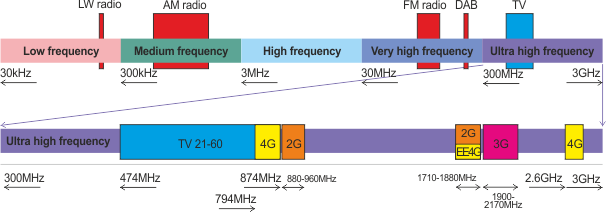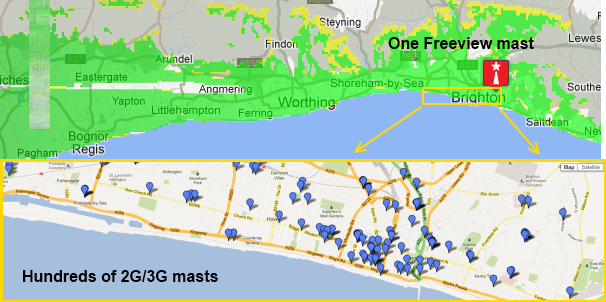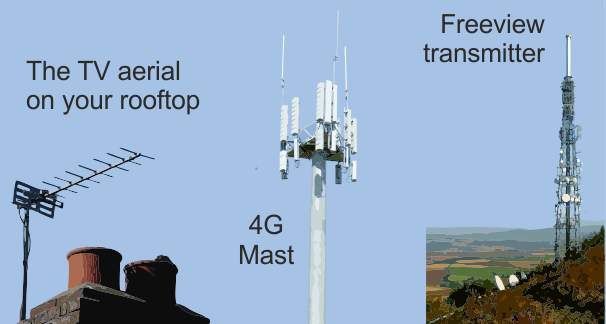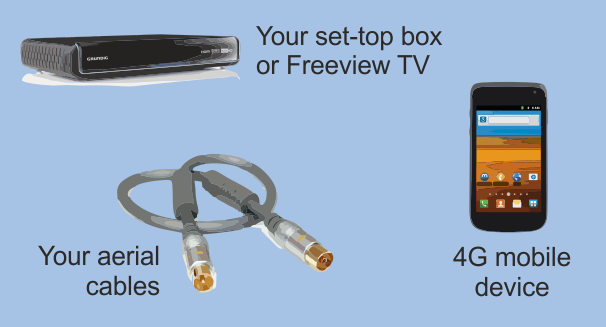How do I know if the 4G broadband will overload my Freeview?
 Brian Butterworth published on UK Free TV
Brian Butterworth published on UK Free TV Back in June 2011, we looked at how Ofcom moves to protect Freeview interference from 4G mobile .
Since then, the television Digital Switchover has been finished and 4th generation (4G) mobile broadband services - also known as Long Term Evoluition (LTE) have launched all over the world, including a service from Everything Everywhere (EE) in the UK.
To understand why and how these 4G broadband services will cause problems during 2013, you need to take into consideration a number of technical factors.
Understanding the radio spectrum
The Radio spectrum is the name given to the frequencies of the electromagnetic spectrum that can be usefully used to transmit radio, television and data services.The top bar on the diagram below (or download) shows a selection of the services used in the UK, with old-fashioned long-wave radio, then medium-wave radio, though FM radio, the digital DAB radio services up to those used for television broadcasting. (See here for a really complex chart).

The highest frequencies on the diagram, the "ultra high frequencies" (or UHF) band is shown enlarged as the lower purple bar. In this range we can see TV "channels C21 to C60" (blue), second- and third- generation mobile phones (2G orange, 3G pink) and the location for the 4G services.
It is important to note that some of the 2G capacity in the "1800MHz" range has already been converted to 4G operation by Everything Everywhere (EE). The other two yellow boxes show the "800MHz" (to the left) "2.6GHz" (on the right).
For the purpose of Freeview reception, only the 800MHz range need be considered. The other two ranges will not cause Freeview problems.
Protecting Freeview receivers against overload
As we have seen already - Freeview signals: too much of a good thing is bad for you - Freeview boxes are designed to protect themselves against signal overloads. When they do this they close down and people often incorrectly diagnose the problem as being "no signal" when there is too much.The problem that has to be solved as the 4G services launch, is that the new mobile broadband signals can cause overloads onto the frequencies that are being used for Freeview.
 One particular problem is that a very common type of Freeview signal decoder, a superheterodyne receivers are sensitive to signals being present nine channels (72MHz) away.
One particular problem is that a very common type of Freeview signal decoder, a superheterodyne receivers are sensitive to signals being present nine channels (72MHz) away.
In addition to overloads, 4G may also cause Signal-Interference Noise Ratio degradation, where reception breaks down because the receiver can no longer decode the digital information in the transmission.
Knowing who will win the 4G auction
 Until the
4G auction takes place, no one will know which company has the right to use the 800MHz channels for mobile devices. The following companies have qualified to bid:
Until the
4G auction takes place, no one will know which company has the right to use the 800MHz channels for mobile devices. The following companies have qualified to bid:
- Everything Everywhere Limited (UK)
- HKT (UK) Company Limited (a subsidiary of PCCW Limited)
- Hutchison 3G UK Limited
- MLL Telecom Ltd
- Niche Spectrum Ventures Limited (a subsidiary of BT Group plc)
- Telefonica UK Limited
- Vodafone Limited
Viewing high power television and using low power mobiles
Using the 'Sitefinder' Mobile Phone Base Station Database you can compare the locations of existing mobile phone "masts" with those used for Freeview Transmitters. Here is an example from Brighton and Hove, where a medium-sized single mast (Whitehawk Hill) can cover a whole city, but where hundreds of mobile phone base-stations cover a many smaller-by-comparison areas.
This illustrates two points. Firstly, that Freeview broadcasts are high powered and one-to-many - mobile devices are low power and peer-to-peer. The mast your TV signal comes from may be miles, sometimes tens or miles away, for your mobile perhaps only meters away.
The second point is that if an existing 2G/3G mobile supplier wins a 800MHz 4G slot, they will wish to use their existing "phone mast" locations (especially the 900MHz ones) as this would be most economical for them. Until the action winners emerge, and then plan their network, only idle speculation about possible interference can be made.
Using the TV frequencies for 4G masts and phones
Research (see here) shows that a 4G mast in relative close proximity, or a mobile 4G handset closer than a meter to an unfiltered Freeview box will cause overloading on many tested devices. The following diagram shows the relationship between the 4G use and the old TV channel designations.
Those Freeview transmitters that use channels above C52 are most likely to have receivers that get overloaded by the use of 4G signals in the 800MHz area. FDD is Frequency-division duplexing - the transmitter and receiver operate at different carrier frequencies.
Interpreting the aerial and mast locations
Once the proposed mast locations for 4G services are known, it will then be possible to predict which homes will need to fit the special filters in areas where Freeview uses the higher channel numbers (the C52 to C60 range).
If you then have a rooftop aerial without a signal amplifier, to get an overload you will need the 4G mast to be in the line-of-sight between your Freeview transmitter and the aerial, or possibly "directly behind" the aerial.
If you then have a rooftop aerial and an amplifier, or perhaps have lower-grade cables, you are likely to need to protect from a 4G overload if the phone mast is close to your rooftop aerial.
Finding transmitters that use the higher range frequencies
Some powerful transmitters and many relays use the high frequencies: Sudbury, Oxford, Belmont, Winter Hill, Tacolneston, Pontop Pike, Mendip, Emley Moor, Clermont Carn, Truskmore and Maghera.Click below to find out the transmitters in with high frequency allocations:
- C60 is used by 126 transmitters - including Sudbury, Oxford, Belmont;
- C59 is used by 142 transmitters - including Winter Hill and Tacolneston;
- C58 is used by 100 transmitters - including Winter Hill, Sudbury, Pontop Pike and Mendip;
- C57 is used by 131 transmitters - including Clermont Carn, Truskmore, Oxford;
- C56 is used by 73 transmitters - including Mendip, Sudbury;
- C55 is used by 139 transmitters - including Maghera, Winter Hill and Tacolneston ;
- C54 is used by 104 transmitters - including Mendip, Pontop Pike and Winter Hill;
- C53 is used by 131 transmitters- including Truskmore, Belmont, Oxford;
- C52 is used by 81 transmitters - including Emley Moor, Sandy Heath, Clermont Carn and Mendip.
Protecting Freeview boxes and sets, cables, amplifiers from 4G devices
Again in areas where Freeview uses the higher channel numbers (C52 and above) you may have to protect your Freeview devices from signals from a 4G handset (such as mobile phone, tablet, or USB "dongle").
This may, once again, require the fitting of a special filter, or the upgrading of the "fly leads" used to connect your aerial to the set top box or TV. This may be a particular problem if you have used an indoor aerial or signal amplifier.
Help with TV/radio stations?
In this section
Monday, 11 March 2013
J
Jo Dee9:07 PM
Worcester
Thank you Andrew, I have checked out all your suggestions - the aeriel goes straight into the back of my Freeview enabled TV, no problems when it rains & the cable comes straight through the wall. We also have an amplifier and there have been no signal problems today despite the blizzards.
I am hoping Digital Mobile Spectrum Limited contact me soon to tell me it's a 4G issue as I'm totally stumped!!
Many thanks,
Jo Dee
| link to this comment |
Jo's: mapJ's Freeview map terrainJ's terrain plot wavesJ's frequency data J's Freeview Detailed Coverage
Tuesday, 12 March 2013
J
jb3812:09 AM
Jo Dee: As it appears as though its possible for you to receive from two different stations, namely Malvern @ 7.5 miles / 219 degrees or The Wrekin @ 35 miles / 337 degrees, the question is which one of the two are you receiving from? If your aerial is mounted vertically then it will be Malvern whereas with The Wrekin its horizontal, but though its a case of making sure that the aerial is receiving channels from the correct station, this can be verified by carrying out signal strength checks on BBC1 / ITV1 / ITV3, because as well as the strength / quality of the signal being seen the mux channel number associated with the programme channel will also be indicated. Mux channels used by both stations being / The Wrekin: Ch26(BBC) - Ch23(ITV1) - Ch30(HD) - Ch41(ITV3) - Ch44 - Ch47. Malvern: Ch53(BBC) - Ch57(ITV1) - Ch60(HD) - Ch50(ITV3) - Ch59 - Ch55.
| link to this comment |
J
jb3812:20 AM
Jo Dee: Managed to get Google Earth working again and a quick check indicates Malvern as being the station you are receiving from, therefore carry out the signal test as described and cross check that the mux channel numbers indicated on each of the programmes tested match with Malverns muxes as seen on the list.
Further advice dependant on reply.
| link to this comment |
Wednesday, 13 March 2013
R
roger8:24 PM
Brierley Hill
i live in brierley hill using amblecote transmitter some nights all bbc stations are unwatchable other stations ok any ideas
| link to this comment |
roger's: mapR's Freeview map terrainR's terrain plot wavesR's frequency data R's Freeview Detailed Coverage
Sunday, 17 March 2013
J
Jo Dee3:41 PM
Worcester
jb38,
Thankyou for your replies. I have carried out a signal test & have ascertained the following: BBC1= ch53, ITV1=ch57, ITV3= ch50. We don't have HD channel 60.
Both signal strength & quality are good today, but I had no signal quality & thus no channels to watch whatsoever yesterday, until the second half of the England/Wales rugby match (and then I wished I hadn't!)
| link to this comment |
Jo's: mapJ's Freeview map terrainJ's terrain plot wavesJ's frequency data J's Freeview Detailed Coverage
J
jb388:39 PM
Jo Dee: Thanks for the update on the mux channel test that you carried out, and which as you have mentioned confirming that your Freeview service is indeed from the Malvern transmitters, however as far as the intermittent problems with reception is concerned, judging by what you have previously reported with regards to having observed that the main issue is one of fluctuating quality to the extent of it being non existent at times, then although I feel that the problem might well be outwith your control you really do have to be able to completely eliminate any possibility of the problem being caused by a fault within your own installation, such as for example a bad (corroded) connection where the coax is terminated on the aerial, as this sort of problem can give symptoms exactly as you have described no matter what the weather.
Of course needless to say, that the only way of verifying as to whether or not the aforementioned possibility applies is by making a local enquiry with any neighbour that you might be on friendly terms with, because other than by taking that action its impossible to know.
| link to this comment |
Monday, 18 March 2013
J
Jo Dee7:06 PM
Worcester
jb38,
Thank you for your response - I have only had a chance to speak to one neighbour so far, but he has satellite!
I will keep up the investigations and invest in a ladder.
Many thanks,
Jo
| link to this comment |
Jo's: mapJ's Freeview map terrainJ's terrain plot wavesJ's frequency data J's Freeview Detailed Coverage
J
jb3811:34 PM
Jo Dee: Yes, please do! as its really important that you find this out before making decisions with regards to further actions that may be taken, as should it subsequently transpire that others are indeed experiencing similar problems to yourself then that effectively makes the situation one of being outwith your control.
Needless to say, I would advise to refrain from making any purchases for the time being.
| link to this comment |
Wednesday, 20 March 2013
D
DR Patten5:22 PM
WHY do we have to pay for extra filters and possibly expensive cabling etc when it is nothing to do with us? Why can't the 4G telecom holders pay? When we lost analogue here in Taunton we had to spend £100 for new aerial etc and loads of hasssle
| link to this comment |
Friday, 22 March 2013
I
ian from notts8:53 AM
DR Patten- people who expieriance trouble because of 4G will not have to pay for filters
| link to this comment |
Select more comments
Your comment please!